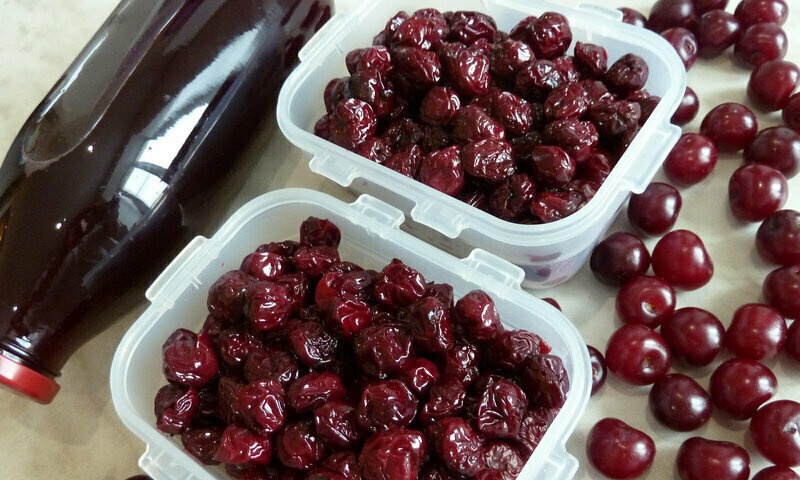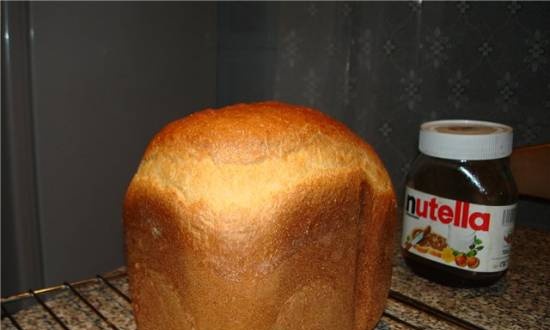Good quality bread
The surface is clean, without large (more than 1 cm wide) cracks, the crust does not lag behind the crumb, is not burnt, the crumb is not sticky, the bread is not wet to the touch, when pressed with fingers it takes its original shape, without flour lumps (impermeability), voids and dense non-porous layer at the bottom crust (hardened).
The taste is moderately sour in rye, and in wheat it is neither sour nor insipid.
Poor quality bread
Musty, bitter or sharply sour taste, crunching from impurities when chewing, foreign odors, hardening, impurities, sticky, viscous crumb with a valerian smell (potato disease), presence of mold.
QUALITY REQUIREMENTS FOR BREAD AND BAKERY PRODUCTS
The appearance of bread and baked goods.
The form must be correct, without side outflows, not wrinkled; for tin bread - corresponding to the bread form in which it was baked, with a slightly convex upper crust; for the hearth - round, oval or oblong-oval, not vague, without imprints.
Surface should be smooth, for certain types of products - rough, without large cracks and explosions; rolls, loaves - with cuts; for bottom products, pricks are allowed.
Crust should have a color ranging from light yellow to dark brown, depending on the variety, without burnt or pallor. The thickness of the crust of bread should be no more than 4 mm; it is not standardized for loaves and small-piece products.
Crumb condition. The bread should be well-baked, not sticky and not wet to the touch, without lumps, voids and traces of impurities, with uniform porosity, elastic. After light pressure with fingers, the crumb should take its original shape, be fresh.
Taste and smell should be characteristic of this type of bread.
Humidity provided by the standard, taking into account the type, baking method and recipe of bread: for simple rye and custard bread - no more than 51%, for wheat bread made from wallpaper flour - no more than 48% ', hearth products have a lower moisture content than molded ones.
Acidity bread is due to the method of preparation of the dough and the type of flour. Rye products cooked with sourdough have a higher acidity (up to 12 °) than wheat products cooked with yeast, and their acidity does not exceed 4 °.
Porosity wheat bread is higher (52-72%) than rye (45-57%), and there is more molded bread than hearth bread. Increasing the grade of flour increases this indicator.
Bread defects.
They are due to the quality of raw materials and arise when the technology of bread production is violated, as well as when the conditions for transportation and storage of bread and bakery products are not observed.
Defects in appearance include:
irregular shape of products, which can be when using flour with a low quality gluten, with improper forming and insufficient or excessive proofing of the dough;
surface cracks are formed when baking bread from fermented dough, and small bubbles - when baking from non-fermented dough;
dark color or a thick crust appears with increasing temperature or baking time;
an increased amount of sugar in the dough causes a dark color of the crust, a lower amount - a pale one.
Crumb defects occur when flour obtained from sprouted grains is used, or when an excess amount of water is added, as a result of which an unbaked and sticky crumb is obtained.
Crumbling due to insufficient amount of water during mixing; crumbling is also a sign of stale bread.
No crumb - the presence of lumps of flour, lobes (old bread) - caused by insufficient kneading of the dough.
Not allowed presence of temper in bread.Hardening is a layer of compacted, non-porous, sticky crumb, usually at the bottom crust. During storage, hardening can occur when stacking hot products in multiple rows.
Taste and odor defects can be when using flour that has been stored for a long time or produced from defective grain. Fermented bread has a sour taste, and unfermented bread has a bland taste. An over-salted, under-salted taste is caused by the wrong dosage of salt. The presence of a crunch on the teeth when chewing bread can be caused by the ingress of mineral impurities into the flour; such bread is not allowed for sale. During storage, the bread acquires a specific aroma and taste of stale bread.
The quality of bread also depends on its baked goods. The crumb of unbaked bread is sticky, inelastic, low-porous. Such bread is poorly absorbed, in addition, it irritates the mucous membrane of the stomach and intestines, disrupts the normal secretory function of the digestive glands.
Some more indicators of the good quality of bread
GOODNESS X. depends, firstly, on the material, that is, the flour from which it is prepared, and secondly, on the degree of perfection of its manufacture.
The main nutritional component of rye and wheat X. are carbohydrates (starch, dextrin and sugar) from 40 - 55%, then nitrogenous substances from 6 - 10%, and a small amount of fat (up to 2.8%).
In the study of X. pay attention primarily to its appearance, taste, color and smell.
In benign X. CRUMB should represent a uniform, loose, spongy-spongy mass with small indentations, uniformly colored, without lumps formed due to insufficient mixing of the dough or due to the preparation of X. from old flour. The crumb must be sufficiently elastic; finger depressions should soon be smoothed out.
CRUST should be of moderate thickness, without large cracks or burnt spots, and should not lag behind the crumb.
X. should not crunch when chewing (the latter indicates an admixture of sand and other minerals).
TASTE AND SMELL should be pleasant and distinctive. Bitter taste and musty smell indicate spoiled flour or admixture of foreign harmful substances.
SPOTS, sometimes seen on the surface of the X. section, are caused by flour lumps, an admixture of weeds, or plant parasites (oidium auranticum, penicillium glaucum, etc.).
In addition, when assessing the goodness of X., the following characteristics are taken into account: duty cycle, specific gravity, moisture and acidity of X.
WELLNESS X. is an important feature in judging the goodness of X. By the degree of the duty cycle, you can judge whether the dough was well mixed and fermented, and whether X was baked enough. To increase the duty cycle of X. various baking powders were invented (Horsford, etc.), and it was proposed to knead the dough with water saturated with carbonic acid under high pressure; but these methods were not widely used. To increase the volume of bread and mask excess water, bakers sometimes try to give X. an excessive duty cycle. According to research by Vinokurov and Troitsky (St. Petersburg), Samgin (Moscow), and others, the duty cycle of rye X. ranges between 19.4% (soldier's) and 57.2% (baked), wheat - from 47.5% (weight) to 75.2% (French bun). Benign X. is characterized by a uniform duty cycle, more or less characteristic of each variety of X.
In rye X. wells, in general, of a larger size than in wheat (see the research of Lehman, Prausnitsa, Davydov in the works named below).
SPECIFIC GRAVITY X. can also give some indications about the goodness of X. According to Lehman, the specific gravity of fresh rye X. ranges between 0.41 - 1.0, and fresh wheat 0.24 - 0.50. The thinner the flour from which X is prepared, the lower its specific gravity.
When examining the quality of X. it is very important to determine the amount of water in it, or the degree of its moisture content.
HUMIDITY X. is to be distinguished from the amount of water that flour is able to absorb, giving it that name. burn (i.e.the difference between the weight of X. and the flour taken to make it). The yield of chrome, that is, the ratio of its weight to the weight of flour taken for its preparation, is determined mainly by the type of flour and the method of baking it.
High grades of flour have a higher water-absorbing capacity, consequently, they give a greater heat, reaching up to 55% (a heat of 32½% is considered normal for rye flour). Bakers, striving to achieve the greatest possible baking, sometimes add water when kneading the dough in an amount greater than the given flour can absorb, giving baking, which results in a raw, heavy X .; the wateriness of X. also comes from poor baked goods (see above) or raw flour. Excessive moisture content of commercial rye X. is one of its most common and harmful disadvantages.
ACIDITY DEGREE X. influences the taste Χ. and its digestibility. According to Lehmann's research, the acidity of X. is determined, firstly, by the presence of organic acids and, secondly, by phosphoric acid potassium, which is formed during the fermentation of dough from the neutral phosphates present in flour. Of the organic acids in each moderately acidic X. there are acetic and lactic, and in insignificant quantities, higher fatty acid; sometimes, apparently, also traces of formic acid and aldehyde. Pokrovsky (St. Petersburg) found 0.718% acetic acid in sour rye X., 0.366% in baked rye, and 0.437% in wheat by weight. In general, the acidity of different varieties of X. varies widely (from 0.1% to 0.9%).
The highest degrees of acidity are found in varieties of rye X. made from coarse flour; wheat X. has a low acidity.
The method of preparation of X also affects the degree of acidity .; made with sourdough X. is more sour than yeast; in the latter case, acids do not have time to form due to the rapid loosening of the dough.
The degree of acidity also depends on the duration of fermentation, As for the influence of acidity of X. on the degree of its assimilation, the experiments of Lehmann and his students, Cohen and Weber, showed that more acidic X. is absorbed better than slightly acidic; however, according to Lehmann, it cannot be recommended that X. contains more than 0.7 - 0.8% acids. For those suffering from digestive disorders, slightly acidic X should be prescribed.
FOREIGN IMPURITIES in X. are caused mainly by the presence of such in flour. The most harmful plant impurities are ergot and cockle. In some localities alum, zinc and copper sulfate are mixed with flour to give it a better color or to revive spoiled flour. Microscopic examination of X. also sometimes gives valuable indications about its good quality; microscopic examination can reveal an admixture of potato flour, weeds, the content of bran, muffins, etc. SURROGATES X. In lean years and during hunger strikes, the population is often forced to replace the missing X. with other plant products. The substitutes for X. are: quinoa, bran, potatoes, millet, buckwheat and peas, chaff, acorns, sunflower oilcakes, beet pulp, distillery stillage, straw, bark, and many others. others. These surrogates are either mixed with rye flour, or X. is prepared from one surrogate material; more often from a mixture of different surrogates. Some of the listed surrogates are rich in nutrients, especially nitrogenous and carbohydrates (potatoes, buckwheat, peas, millet), but X., prepared from them, usually has a very bad taste and is difficult for the body to absorb. Others not only have very poor nutritional value, but cause various gastrointestinal diseases.
How in the old days the quality of bread was monitored
In the 16th century, bakers in Russia were already subdivided into bread bakers, kalachniks, pies, gingerbread cookies, pancakes and rushes, making up a significant part of the city's artisans. They baked various types of rye and wheat bread, baked goods, pies, and gingerbread.
In the cities of the Moscow principality in the XVI-XVII centuries.government control was established over prices in the retail grain trade and over the quality of products sold. The Tsar's decree of 1626 "on bread and roll weight" approved the procedure for setting prices for 26 types of bread made from rye flour and 30 varieties from wheat.
To monitor the exact implementation of this decree and the observance of the established prices for bread, bread bailiffs were appointed to the markets and torzhaki, who were obliged ... to walk in the Kremlin, in Kitai-gorod, along the streets, lanes and small marketplaces and weigh sieve bread , sieve and rolls grated and soft rugs. If the bailiffs found that the bread and rolls did not meet the established weight or were sold above the approved price, the perpetrators were fined. The guilty had to pay a lot of money. In case of serious violations, the culprit was subjected to corporal punishment.
And under Peter I, even stricter laws were established, regulating the prices of bread and determining the punishment for their violation. By Peter's decree of January 14, 1725, for the sale of raw or low-weight bread, the bread traders and bakers were severely punished: ... "and for that ... beat with batogs or cats and take that raw and low-weight bread to the hospital."
And the officers of the police chief's office carried out supervision.






